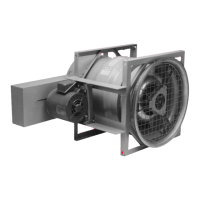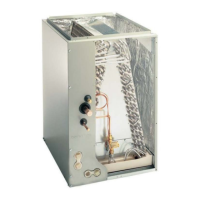UV-PRC001-EN 49
having laminar flow in the coil in-
creases. This again is because gly-
col is more viscous than water.
With these effects in mind it is im-
portant to use a minimum amount
of glycol to protect the HVAC sys-
tem.
Burst Protection vs. Freeze
Protection
• Burst protection is sufficient in
systems where there is ade-
quate space to accommodate
the expansion of an ice/slush
mixture. The protection works
as follows: As the temperature
drops below the solution’s
freeze point, ice crystals begin
to form. Because the water
freezes first, the remaining
glycol solution is further con-
centrated and remains fluid.
The combination of ice crys-
tals and fluid make a flowable
slush. The volume increases
as this slush forms and flows
into the available expansion
volume (usually an expansion
tank). When a sufficient con-
centration of glycol is present,
no damage to the system will
occur.
• Freeze protection is required
in cases where no ice crystals
can be permitted to form or
where there is inadequate
expansion volume available.
HVAC systems intended to
start-up in cold weather after
prolonged winter shutdowns
may require freeze protection.
Table 21 is provided by Dow
Chemical Co for its ethylene
and propylene glycol prod-
ucts:
Selection Procedure
Glycol Adjustment Factors
Glycol in an HVAC System
Because the detrimental effects of
glycol are lower at high tempera-
tures, little concern is given to ca-
pacity loss or increased pump
power when glycol is added to
heating systems. This is why it is
not uncommon to see glycol per-
centages up to 40 percent in the
heating loop of a system. Howev-
er, the same is not true for cooling
systems. Concentrations of this
level are intolerable in cooling sys-
tems where fluid temperatures are
lower. The viscosity of the glycol
increases as the temperature of
the mixture drops. This not only
decreases the effectiveness of the
heat transfer, but it also makes the
mixture more difficult to pump. To
make things worse, as the percent-
age of glycol increases, the risk of
Table 21 shows that a 30 percent ethylene glycol solution is enough to burst protect a system down to -60 de-
gree F. Because of the benefits of burst protection, excessive glycol only degrades the heat transfer and in-
creases the pressure drop of the fluid without providing additional system protection. Use glycol correctly.
Table 21: Percentage Volume Glycol Concentration
Temperature
Degree F
For Freeze Protection For Burst Protection
Ethylene Glycol Propylene Glycol Ethylene Glycol Propylene Glycol
20 16% 17% 11% 11%
10 25% 26% 17% 18%
0 33% 34% 22% 23%
-10 39% 41% 26% 28%
-20 44% 45% 30% 30%
-30 48% 49% 30% 33%
-40 52% 51% 30% 35%
-50 56% 53% 30% 35%
-60 60% 55% 30% 35%

